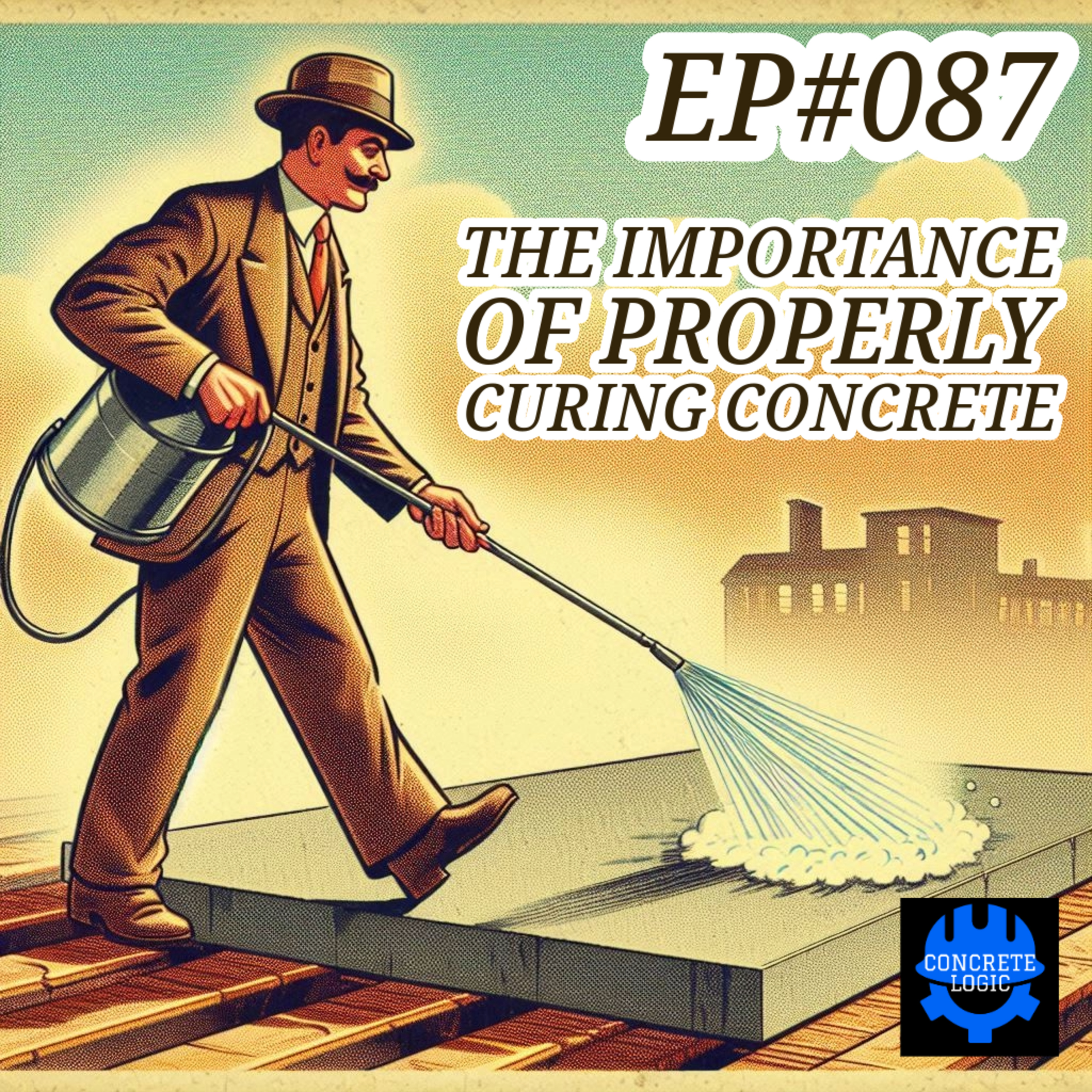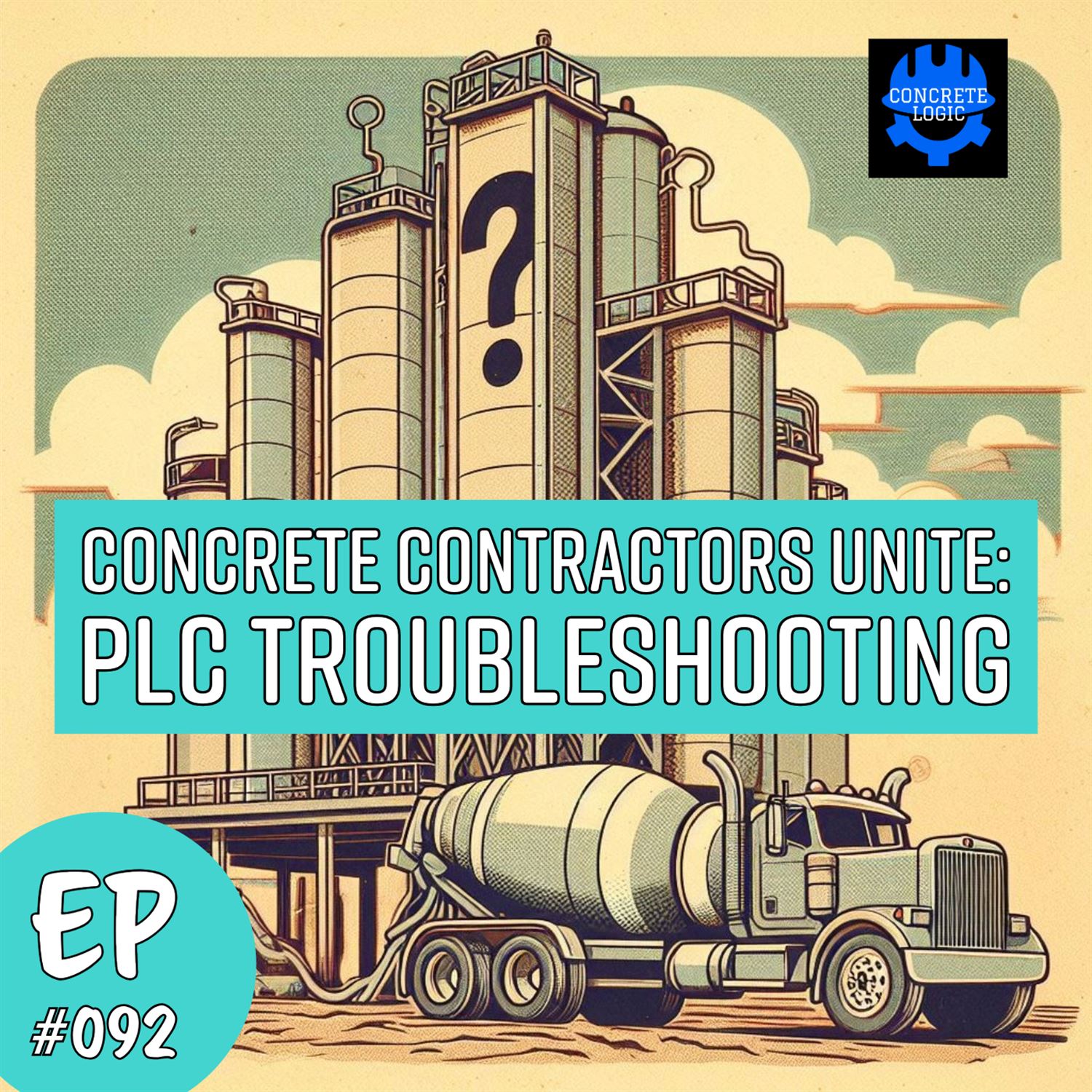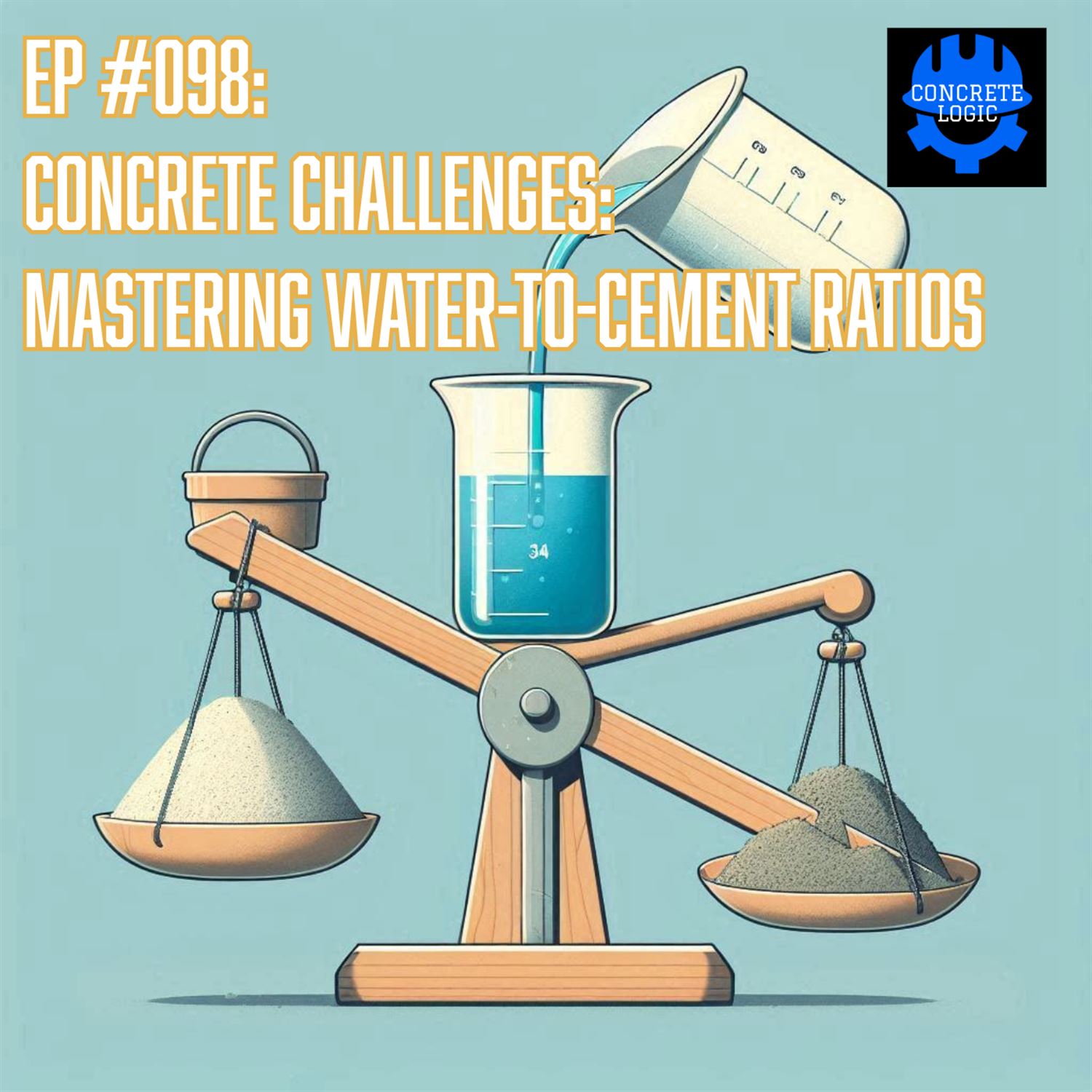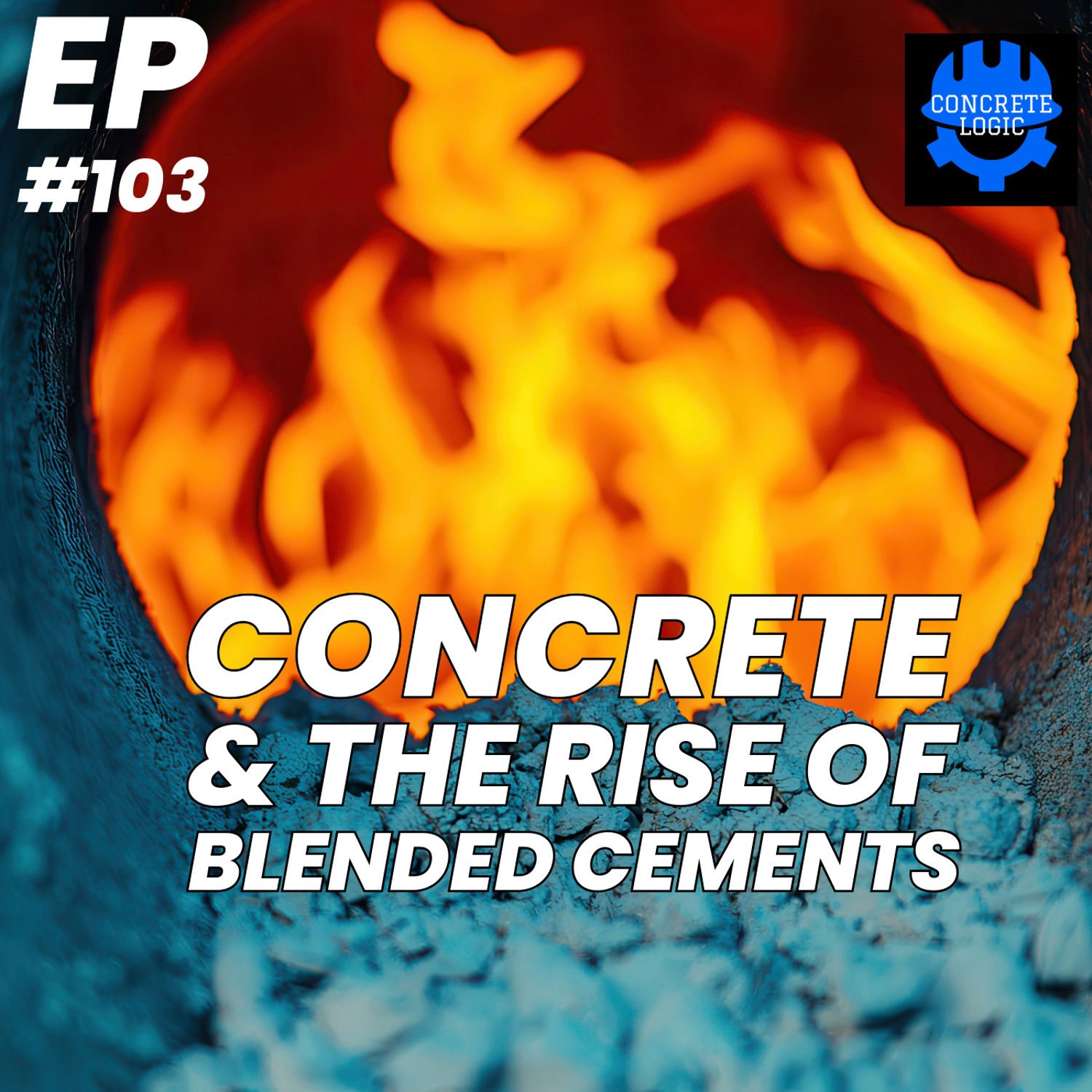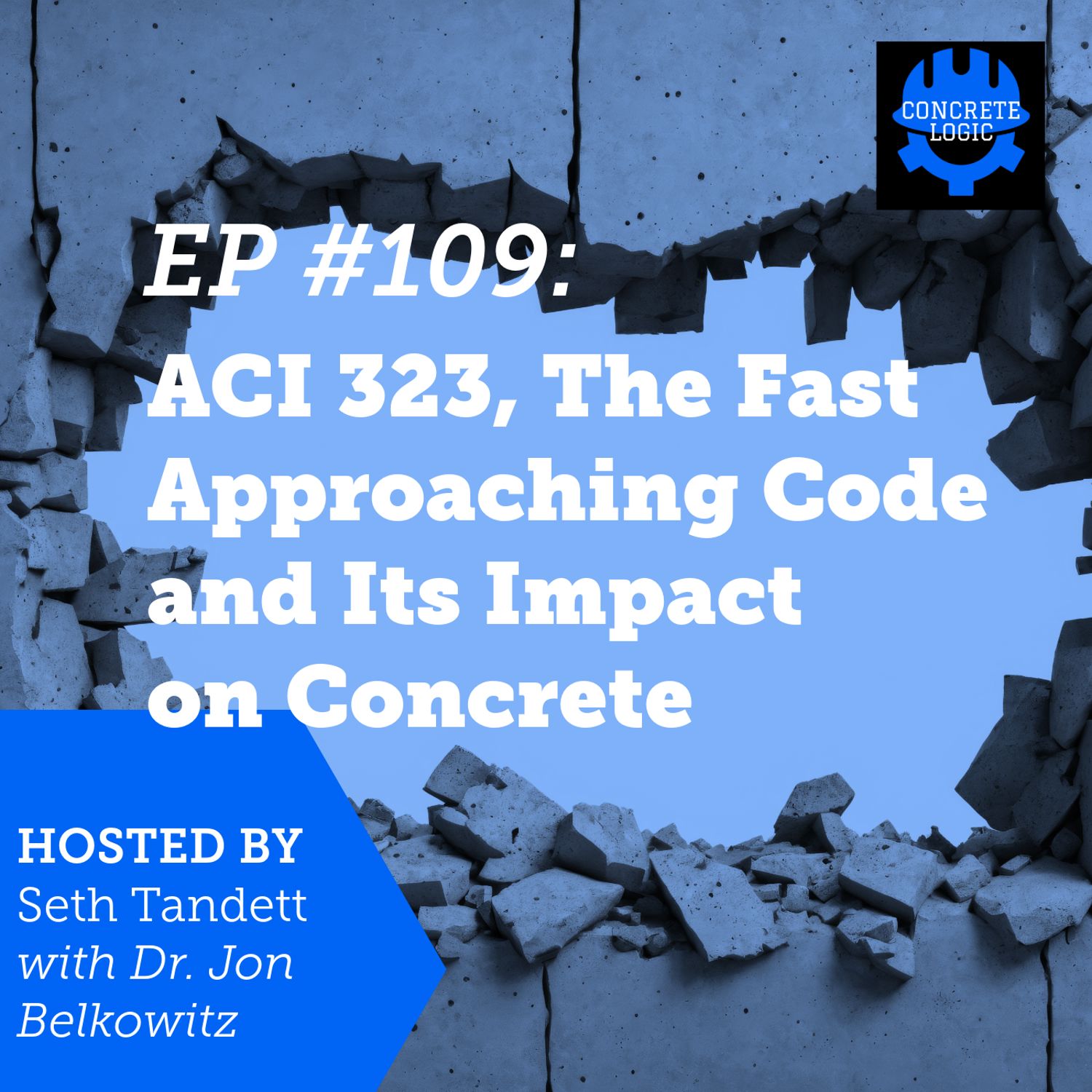EP #093: Colloidal Silica: The Nano-Particles Concrete Dreams About

In this episode, Dr. Jon Belkowitz and Seth discuss colloidal silica and its various applications in the concrete industry. Dr. Jon highlights the differences between colloidal silica and silicates, emphasizing the benefits of using colloidal silica as a densifier and for surface treatments. He also mentions the ongoing efforts to create an ASTM standard for colloidal silica.
The conversation touches on the importance of performance testing and the potential long-term impact of using colloidal silica in concrete.
Takeaways
• Colloidal silica is a controlled suspension of nano-sized particles of silica, typically between 1 and 100 nanometers in diameter.
• Colloidal silica is used as a densifier and for surface treatments in the concrete industry.
• Silicates, on the other hand, react quickly and create a gel-like surface, which can limit penetration into the concrete.
• Using colloidal silica instead of silicates can provide longer-term benefits and reduce the risk of issues like hydrolysis in flooring systems.
• The ASTM is working on creating a standard specification for colloidal silica use in concrete, including performance testing.
• Colloidal silica offers ease of finishing and can help prevent issues like pinholes in the concrete surface.
Chapters
00:00 Introduction and Overview
03:06 Definition and History of Colloidal Silica
07:16 Differences Between Colloidal Silica and Silicates
13:15 The Importance of Using the Right Materials in Concrete
26:07 Progress Update on ASTM Standard for Colloidal Silica
***
Did you learn something from this episode? If so, please consider donating to the show to help us continue to provide high-quality content for the concrete industry.
Donate here: https://www.concretelogicpodcast.com/support/
***
Episode References
Guest: Dr. Jon Belkowitz | Intelligent Concrete | Jon@intelligent-concrete.com
Guest Website: https://www.intelligent-concrete.com/
Producers: Jodi Tandett
Donate & Become a Producer: https://www.concretelogicpodcast.com/support/
Music: Mike Dunton | https://www.mikeduntonmusic.com | mikeduntonmusic@gmail.com | Instagram @Mike_Dunton
Host: Seth Tandett, seth@concretelogicpodcast.com
Host LinkedIn: https://www.linkedin.com/in/seth-tandett/
Website: https://www.concretelogicpodcast.com/
LinkedIn: https://www.linkedin.com/company/concrete-logic-podcast
Seth (00:01.231)
Welcome to another episode of the concrete logic podcast and Dr. John Belkowitz is back with us. It should be, this is number eight, eight, number eight. All right. So we're going to talk about colloidal silica today. We haven't talked about that in a while. So I thought we would, rehash that. And plus it makes Dr.
Dr Jon (00:14.03)
8.
Seth (00:28.527)
Belkowitz happy to talk about it. So that's why we're choosing that today.
Dr Jon (00:32.078)
You know what else makes me happy to talk about?
the t -shirts. And I just wanted an update on the t -shirts.
Seth (00:41.903)
All right. Well, I'll give you an update. Nothing's happened. Nothing's happened. So, before, before we, we had, spend time talking about t -shirts, I just want to remind everyone how this works. the, the podcast. So I, I bring folks on like Dr. Belkowitz and give you, a bunch of knowledge for free. Just throw it out there.
And what I ask for you in return is to do three things for me. You can do one of the three things, but just do one of them, please. One is share the podcast with a colleague or coworker in the industry or even outside the industry. Get somebody that's outside the industry, get them involved in concrete. the second thing you could do is you go to concrete logic podcast .com and there's two ways to get ahold of me. There's a contact link.
it's up at the top. I'm on the website right now. It says contact click on that. You can shoot me a message and you can do what Dr. Belkowitz did for me this morning. Give me a guest suggestion. He gave me a guest suggestion who I reached out to or a topic suggestion, either one. So that way that, we make these episodes about what you want to hear about and not just what I want to talk about. And then the last, the last thing is if, if you find there's value in this show.
you can show, show your, give value back, in a monetary way by hitting the donate button that's on the website as well. So I click donate and then you can give any amount and any amount is muchly appreciated. It's just your way of showing that you're listening and you're, you're learning something from the show. So with that, we could talk about t -shirts real quick. If you want to, I've done nothing with the t -shirts. I've.
Dr Jon (02:32.686)
I have no interest in talking about t -shirts.
Seth (02:37.007)
Okay. Eventually there'll be a, some kind of t -shirt. Well, we'll, we'll, we'll figure it out at some point, but, it's been a busy part of the year, you know, it's summertime. It's the season of concrete. So it's, it's, it's been busy. yeah. So, but, colloidal silica, let's, let's talk about that and maybe we should, you should start off by reminding folks what it is.
and what we use it for, what it can do. I know it's a favorite subject of yours.
Dr Jon (03:14.51)
absolutely. And, you know, a good definition of colloidal silica. We have one written up in our ASTM, which is part of our discussion here. Do you mind if I open it up real quick?
Seth (03:27.919)
I know that'd be great.
Dr Jon (03:30.35)
you know, and, and just to give you a background on colloidal silica, the history of it, it's been around since the 1800s. And, you know, I think the first patent for it was back in 1959. And the person that I attributed to it, there are a bunch of other folks out there that like to give other people credit for it. You know,
I'd like to give Brian Green from the US Army Corps of Engineers the credit for bringing colloidal silica, not only to ground and mortars, but also to the concrete construction industry with his work on ultrafine amorphous colloidal silica for rock matching grouts. Great research paper if you've never read it. It reads like Mark Twain or...
You know, call me Ishmael, you know, which wasn't by Mark Twain. Anyway, so a definition for colloidal silica, which you also might find it in the literature as silica soles, is a controlled suspension of nano silica sized particles anywhere below one micron because that...
effectively is in the nano realm, but normally it's considered between 1 and 100 nanometers in the concrete industry. And there are others that will push it up to 150 nanometers in diameter. Just to give you a reference, human hair, not on your head or my head, but human hair has a diameter of around 100 ,000 to 150 ,000 nanometers in diameter. So a nanoparticle...
that we're talking about this nano silica can be anywhere between one and around a hundred nanometers in diameter. You know, just a little bit bigger than a water molecule, if you will, and a little bit larger than that. And the reason why we like it is because these ultrafine amorphous particles in suspension, which are not affected by gravity, they react well, not only with concrete and things like pozzolanic reaction.
Dr Jon (05:53.518)
But then you get particle -particle packing, you get void filling, and then you get things on the chemistry side of it, like accelerated cement dissolution or instantaneous pozzolanic reaction or internal curing from a hydrogel creation. Now, it should be noted that there is a separation between colloidal silica and the raw material that's used to make...
colloidal silica, which is considered to be silicate. Now, the first thing, I guess, is the pH. When you look at a colloidal silica, they are below a pH of 10 .8. Anytime we hit a pH of 10 .8 with colloidal silica, what you start seeing is this dissolution or this dissolving of the solid species. Once we hit that pH of 10 .8, you don't have those...
large or excuse me, nanoparticles in solution, now you have solutes in solution. So it's really the pH, which colloidal silica can't be above really 10 .7. Once we hit 10 .8, your silicate, and also it's the size of the particle too. Silicates are solutes in solution as opposed to colloidal silicas are discrete particles in a suspension.
Seth (07:16.975)
So at that point you would lose the, I guess the beneficial attributes of silica, right? Or what would a silica...
Dr Jon (07:28.142)
Yeah. So it's there. The benefits to a certain degree are similar. but it's really the fact that there's, it's a lot harder to control the silicates. Let's say when you're using them as a densifier, silicates have traditionally been used in the concrete industry for the last, what, four or five decades as concrete densifiers.
you know, top surface topical admixtures and man chevets, are they great? You know, far be it for me to say silicates aren't a good technology for concrete. I freaking love silicates, especially when you start combining the different types, but there is a specific use for them. And the unfortunate reality is that people don't often use them in the right places. Now using it as a densifier, if you're polishing,
It works great because it impacts, it's so reactive. That's the thing. It's a solute in solution. It's very, very small. There's a lot of salt with it. So it will react pretty darn quick. That means we're not going to get the depth of penetration if we want to impact the concrete through the surface, into the subsurface, into the body of the concrete, like we can do with topically applied colloidal silica. Again, much larger particles that don't react as quickly. Oftentimes,
when you're using a silicate densifier versus a colloidal silica, if you have the same concrete, you separate it with a piece of tape, silicate on the left, colloidal silica on the right, what you'll see is the colloidal silica, when you apply it topically, it looks like it's drying faster. When you look at the silicate, it looks like it's pooling and ponding on the surface. With the silica, it's just a...
absorbing or dispersing or diffusing into the concrete. You're not seeing it dry, you're seeing it dive into the concrete with the silicate. It reacts so dang quick that it creates a boundary layer or a gel that prohibits more of that solution to penetrate into the concrete. So you are effectively pooling or ponding on the surface. There's a concrete polishing guy out there.
Dr Jon (09:53.198)
He reminds me of a, what's it called? A band from the 80s. I think his company is called Extreme Polish. He has another great guy for you to have on the podcast. He's got some awesome videos where he does the comparison and he literally does what I just said. And you can see the difference between Silicate and Silica.
and you'll see almost like a glassy surface. That's because the silicate is gelling at the surface. It's reacting really quickly. Now, you can mechanically use that and, what's it called, finish it into the surface, if you will. But again, it can only penetrate so deep and therefore it only has such penetrate or has such an impact. The other problem with silicate is, bear in mind,
you have a lot of salt for one SiO3. Somewhere on my computer, I have a wonderful presentation, I can send it to you and you'll have some great pictures to put on the podcast. That salt content, usually in the form of sodium or potassium, can cause issues for concrete, especially, excuse me, sorry about that, especially...
If we're using the concrete floor for, let's say, a resilient flooring, an adhesive with a rollout tile or vinyl tile or rubber flooring. Right. You know, you did a podcast with the great Robert Higgins. You've got to read his last two articles.
Seth (11:30.015)
Applied flooring, you're saying. Yeah.
Seth (11:38.447)
Yes.
Seth (11:44.047)
I read everything he puts out.
Dr Jon (11:46.798)
There was one, I think it was the second to last one was on sodium content in the concrete and how it drives moisture content. I want Robert, I would love to work with Robert on an article about the hydrolysis.
of adhesives in the flooring industry because a lot of these potassiums and sodiums in combination with moisture will cause a breakdown of the adhesive and then you see that delamination. It's called hydrolysis. A lot of folks incorrectly call it re -emulsification. And basically what's going on is you have this overabundance of salts.
The pH increases, of course you have the moisture that goes with it. It's an environment that is not conducive to the life cycle of the adhesive. And then there's either a, whether an electron donator, an electron acceptor, I've got to do more research into hydrolysis. That's why I want to write this article with Robert, but basically you break down the glue and we have all these issues. If you look at, I believe it's ASTN.
F310, it's either 710 or 3101. It's the flooring ones for resilient flooring and a coated floor. I want to say that it's within the top two paragraphs that it says that you have to remove all reactive compounds and you cannot use reactive compounds on the surface.
Seth (13:15.119)
Mm -hmm.
Dr Jon (13:29.742)
I believe there's also, if you look at ASTMC 309 and 1315, I know for a fact in those paragraphs, it stipulates that they have to be non -reactive compounds with the surface. As it turns out, over the years, there have been a lot of companies that have been selling silicates in the guise of colloidal silicase and...
It doesn't take a very long Google search to find out some of these companies, but they were selling the silicates as a way for contractors to reduce the amount of time to put their flooring system on. Right?
Seth (14:19.407)
Mm -hmm.
Dr Jon (14:20.526)
And I don't know if Baker did any concrete or hospitals with vinyl tiles or schools or anything, but some of your contractors might've been introduced to this topical additive that, hey, put this topical additive on and instead of waiting, you know, 30 days for every one inch of concrete, now you can put your flooring on in seven days. And don't worry, you don't have to test your concrete. Trust us, it works. Now that works short -term.
Seth (14:41.103)
Mm -hmm.
Dr Jon (14:48.462)
But long -term, and I encourage everybody to read Robert Higgins' article with the amount of sodium that you're putting on the surface, you're eventually going to draw moisture. That combination increases the pH and problems ensue. So short -term, the silicates were what seemed like a great opportunity to reduce the critical path.
But what we're finding now is those jobs done in 2014 through 2017, they're causing some issues.
Seth (15:27.087)
do.
Dr Jon (15:29.39)
Now, I like the idea of using a silicate in areas where we have soft water, where we have acid attack, like manure pads, manure basins.
Like how awesome is it to use a silicate in a manure basin where you have a pH of a 2 .4 to 3 .2. Thank you for choosing this topic. I'm in such a good mood, Seth. This was a much better idea. I really do appreciate that. Again, so have you ever studied acid attack on concrete, Seth?
Seth (16:08.719)
No, sounds interesting.
Dr Jon (16:10.926)
Whitney wrote, bless Whitney's heart, she wrote a paper years ago, I believe she was doing a project at not Idaho, North Dakota, University of North Dakota with Daba Gaddafa, Professor Daba Gaddafa. And they did this whole research on acid attack of concrete with colloidal silica. And we were doing it for a couple of mining companies, or they were doing it for a couple of mining companies, or sponsored by. And what we found is...
is that once you hit a pH of 2 .4 to 3 .2, something has to be sacrificed to raise the pH.
Otherwise, the calcium silicate hydrate structure will start to give out electrons or start to break down to balance that pH or raise that pH to neutrality. Because remember that pH always wants to go back to neutral. If there's something, if there is not something there that can raise the pH, the concrete surface will sacrifice itself. And when I say the concrete surface, I want to be specific.
That's the hydrated cement matrix, the calcium silicate hydrate. pH is lower for stronger calcium silicate hydrate, the type 2 or the inner product. The pH is closer to 3 .2 for the weaker or type 1 calcium silicate hydrate or the outer product that isn't as dense. Right? If you use... Check this out, right? If you use...
a just standard concrete, right? Let's do a type one to a water cementitious ratio or a type one L I guess nowadays 1250 on the rock, 1750 on the sand, no freaking water reducer, no air and training admixture, a water cementitious ratio of 0 .45 and we'll say a total cement content of 564 pounds, right? Your
Dr Jon (18:23.566)
And you use this for some type of poop basin, a manure basin, agricultural basin, even a shit tank, you know, for a clarifier.
Your poor water solution of the concrete will have a pH of what, Seth? Give me a guess.
Seth (18:43.599)
No idea.
Dr Jon (18:44.59)
somewhere between, let's just say, 9 and 11. Right? Well, I mean, the pH of standard concrete is somewhere around 10 to 11. Right? Let's look it up. What does Wikipedia say? pH of standard concrete.
Seth (18:49.327)
wow.
Dr Jon (19:04.59)
Okay, sorry, freshly poured concrete is 12 to 13, and then it reduces after that, right? Now it reduces because we're starting to go through some chemical reactions and we're converting the alkalize and hydroxides into nano gels called calcium silicate hydrates, so the pore water or the pore water solution, the pH dissolves, or I'm sorry, lowers. If we use...
A sodium or potassium silicate, whether it's a topical solution or my favorite way of doing it is an integral admixture for concrete that is meant to be used for, let's say manure basins. We're creating an environment where we're going to effectively have more salt in our poor water solution. So that means our poor water, our poor water.
Our poor water solution will act as that buffer solution to drive down that pH. So the poor water is the sacrificial, not the calcium silicate hydrate. And dang it, if that's not a good idea, the same thing with soft water attack. It's the same fricking principle. gosh. And, and I, I tell you, I've seen more companies sell.
silicate to concrete polishing companies, which, hey, that's a great idea, or schools, hospitals, you know, other fricking flooring companies that are going to be putting resilient flooring system down. And then the contractor doesn't do a good job and, you know, refer to Robert Higgins paper and your adhesive breaks down.
Seth (20:56.815)
Mm -hmm.
Seth (21:01.519)
Hmm. But what's, let's get back to silica's.
Dr Jon (21:01.614)
Mm.
Dr Jon (21:08.526)
So, I like, let's go back to the same scenario. You look at most silicas, colloidal silica, you know, I love the way Ryan Green writes it, ultrafine amorphous colloidal silica, right? Like what a, it's like poetry. pH is much lower. When you look at a silicate, your pH is anywhere between 12,
You know the upper 13s middle 13s, and I've seen 12 .3 for up to 13 .2 Again we can use that in the situations we described colloidal silicase are below 10 .7 Most of them are in a pH of like 8 to 9
You can even get colloidal silicas in the pH of 3 .4. That's for very specific situations, but you can get acidic colloidal silicas. They do not like, silica does not like the high pHs. Hence the reason we have alkalized silica reactivity. So if we use colloidal silica at a pH of let's say nine, instead of a silicate for let's say hospitals,
then you're not creating the same environment. You don't have the same amount of sodium that will drive the moisture up that'll create that hydrolysis. Now you have a much more stable environment.
don't need to use as much product or excuse me, I apologize, I meant to say that differently. I was trying to say it all classy. You might need to use a little bit more product.
Dr Jon (22:55.15)
And it might be a little bit more expensive than the silicate, but you're going to have a much longer term positive impact. It's like, I had to have a discussion with my team yesterday about investing in social media versus search engine optimization. Right. And this is something I often think that you have to consider too, you know, for your podcast.
Social media is amazing because it is a low barrier to entry when it comes to finances and you can see the impact almost immediately. Right? Right? You'll see the engagements, the like, the comments, the shares, right? The numbers will, you'll see like a spike in the chart. Search engine opt, but excuse me, with social media, it's short -lived.
You know, two days later, it's gone. Maybe even 30 minutes later, it's gone. There's no lasting effects. And if you do it the wrong way, it can also have a negative impact. Like for me, if I ever share any of the wildfire videos on LinkedIn, my numbers drop. I think it's hugely important, but...
Short term, it did nothing for me. Long term, I had to work really hard to get those numbers back up, right? With sodium silicates, it's the same thing. Short term, it helps for flooring issues, right? You know, reduce the water migration, moisture, but long term, it doesn't help us much. It hurts us. With colloidal silica, just like SEO for search engine optimization, costs a lot more money. Initial investment is very high.
Then you need to do some advertising and it takes like 90 days to even see a positive impact with search engine optimization. But even after those 90 days, the value added performance, it just compounds.
Dr Jon (25:06.51)
So I personally would rather use colloidal silica and search engine optimization than sodium silicates or potassium silicates and social media to grow our business and to treat a concrete floor that would receive resilient flooring.
And that's me personally. I'm not, I'm not recommending anything for the industry. I know there are people that swear by a certain technology and God bless them. but I'm also the lead or the, what is it called? The expert, witness that has to come in and be part of these challenges, these mediations. And I hate to use the word, but lawsuits. And I've been doing that for the last decade and a half.
Seth (25:55.919)
Mm -hmm.
Dr Jon (25:58.51)
So, silica is going back.
I had notes and we just deviated from them.
Seth (26:07.567)
We always do. That's what makes this fun. Is the ASTM that you were working on, is that out? The standard.
Dr Jon (26:09.006)
You know?
Dr Jon (26:13.802)
It is definitely out as something called a WK, which is a working draft. WK80609? No, that's my old zip code.
Seth (26:23.247)
Okay.
Seth (26:31.119)
Yeah, we had this trouble last time. We talked to him.
Dr Jon (26:33.294)
don't you say that. No, we didn't. No, we didn't. It's WK60809. And I can show it right now.
Seth (26:42.799)
Yeah, cause I, I'm having a hard time finding on it on the ASTM website.
Dr Jon (26:47.982)
whatever. Just look up WK6089. Are you an ASTM member?
Seth (26:54.639)
No. I got to join.
Dr Jon (26:55.47)
That's why. So we've been working on this for six years. What's that?
Seth (27:02.671)
join right now. I'll join right now.
Dr Jon (27:07.63)
ASTM, you know, people often make fun of it that, if we start a new ASTM, my grandchildren won't see it. And man, Shevitz is that rude. You know, screw those people for saying something and assuming that creating a legally binding standard or practice or certification process is an overnight thing. Shame on them.
And especially for colloidal silico, which I mean, man, chevets. It looks like an admixture, but it acts like a supplementary cementitious material. Like, I remember when we were first trying to get this into the industry back in the, what I think it was like 2006, 2007, I was trying to teach people.
Seth (27:47.247)
Yep.
Dr Jon (28:02.222)
how to use colloidal silica or do an equivalent replacement of the surface area that you get from class F fly ash with the surface area that colloidal silica and I'm trying to teach this to batchmen. And they had no clue what I was freaking talking about, which I don't blame them. all right, let's see.
Hey, Tom. All right, let me open this up. I'm doing a podcast light right now. Just let you know, buddy.
Okay,
Give me two more seconds here. So where we are at, we are at the tail end of finishing up the ASTM for Colloidal Silica. It's taken a long time to get the group together. We needed the right amount of manufacturers, distributors, so it was more than just starting it, it was also creating the book or the group. That group came together and we have been working our tails off.
And the impasse that we have run into, there's a, there's a changing of a, of the guard at ASTM. And what I mean is, is that you don't have the same people who created ASTMC 618, 1240, 989, those other ASTMs for, you know, supplementary materials for use in concrete like silica fume, slag, you know, and fly ash. You have different people and because of that, they want.
Dr Jon (29:45.006)
different things. And, you know, years ago we convinced the industry that we had to go to, what's that called? Performance. We need performance and you know, our industry fricking generalizes everything. so we did just that. We generalized the concept and now we want to see performance for everything. And that's what the impasse is.
they want to see a performance section to this WK60809 to show that the colloidal silica does anything for the concrete. Which I respect it and if that's the little that we need to do to... How do I share my screen? To get this passed and that's what we're going to work on.
Seth (30:41.199)
down at the bottom.
Dr Jon (30:43.566)
I got you.
There it is. Okay, so here we are. This is the... geez.
This is the rationale, which goes over the history, the reason behind this, how we're going to separate it in the future. And this is where what we're working on right now. We've got the different types. Now we're going to the different classifications and through the classifications or the classes, we'll create a testing protocol that looks at performance. And then here it goes over the growth over time.
And then there's a much larger appendix to the rationale that we've, like I said, we've been doing this for seven years now. So it goes into a much deeper history and you know, the health aspects, you know, the use in concrete and the benefits to it, some of the job sites that need for an ASTM and then the raw or the ballot history. This rationale will disappear.
once we published the ASTM, but it's a great read nonetheless. And it's got some great references that we threw in there. The standard specification for Cluedle Silica Use in Concrete, when I created it, when we went from it looking like an ASTM for an admixture, the direction that we took was we wanted to use the ASTMs for silica fume for fly ash.
Dr Jon (32:26.254)
for slag as our rubric. So when you look at the title, it's standard specification for colloidal silica for use in concrete. It's identical to those other ASTMs there for silica fume, except for changing out the term colloidal silica. And in this, what we do is originally, it was supposed to be a materials specification only.
And what that means is first we had to define the colloidal silica, which I didn't want to create a definition that I thought would trump what was used here. What a wonderful definition. Acquiesce dispersion of amorphous silica particles having a diameter between one and a hundred nanometers and a solution pH no greater than 10 .8.
And it goes into a deeper discussion here of what a colloidal silica is and how it is separated from other technologies. But ultimately the purpose of this was, and I'll shut up here in a second, Seth. This was a way for the entity that bought the colloidal silica for use in concrete.
to verify that what they ordered from the website or from the distributor or the manufacturer is what they received. And it was a way for the manufacturer to ensure that what they were sending from their warehouse is what was logistically transported to them through their gates at the end of the day. That's ultimately what it was supposed to be.
just almost like a uniformity check. You first identify that we're actually using a colloidal silica, and here we have chemical requirements, physical requirements, and then we get into the test for those, but it was nothing more than that. The difference being now is we're starting to include performance tests to identify the difference between one colloidal silica and the next.
Dr Jon (34:45.614)
And this is what a certificate of analysis would look like.
Seth (34:51.919)
So the idea is colloidal silica going to be listed as an SEM in specifications.
Dr Jon (34:58.926)
Right now, yes, it falls under the ASTM Committee for Supplementary Semanticious Materials. And man, I always get confused with the numbers. I think it's 0924. Let me see. I believe it's at the beginning of this. Committee 09. I believe it's either 0923 or 04.
Dr Jon (35:28.43)
Let me look that up.
Dr Jon (35:35.662)
ASTM.
Dr Jon (35:40.75)
Aggregates and pozzolanic materials. Yeah, so we're part of 0924 just like ASTMC 618. As a matter of fact, the guy who's in charge of ASTMC 618, he's like our group leader, mentor. It's Larry Sutter, who is another person you should have on your podcast because he's freaking amazing.
Seth (36:15.279)
What's the time? What would you think the timeframe is? Yeah.
Dr Jon (36:18.446)
six months to a year. You know, it's not easy to, it's easy to write this stuff. What's hard is, is you've got, you know, 20, 20 people, or excuse me, 30 people now in our own subcommittee who have to agree to somebody, to agree to all this shtick. And then it's not just the subcommittee that we have to go through, which is the 0924, but then we have to go through the main committee.
So it's constantly convincing people and it's just a parliamentary process. And again, it's necessary because ultimately people are going to be held to the wire. This is going to have an effect on how people sell materials, buy materials, how it's governed back and forth. So it's important that we go through this laborious process and it's a pain in the butt, but it's got to be done. So six months to a year.
And if it takes longer, no Khebesa. I don't want it to, but if it does...
Dr Jon (37:22.926)
The point is not that we get there. We don't want right now. We want it right.
Seth (37:28.175)
Right, yeah. Yeah.
Meanwhile, there's folks that are using it, right? And getting the benefits of it and not waiting for it to be standardized.
Dr Jon (37:40.462)
No, and I'm one of those, you know, we, we operate our own colloidal silica company called Eddie stone. And just like everybody else out there, we use ASTMC 494 type S, for a special performance ad mixture as the, the, way to give the industry a do no harm to their concrete. And I, it's a, it's, it's a, you want to talk about a process. I mean, that's a minimum one year process to.
Certify that your product is not going to do any harm to the concrete. Great series of tests.
And yeah, folks have been using that, the 494, as a way to get their colloidal silica product into the industry for a better part of a decade plus.
Dr Jon (38:37.806)
I should that if it's a good song.
Seth (38:39.343)
There you go. Well, I think we're close to wrap it up. Is there anything else you wanted to hit on before we end the show today?
Dr Jon (38:46.658)
Is there anything else? No, no, no. I recommended there was something that the folks at Add 10 More Gallons did at the end of every show, which was ask you what was your favorite concrete experience or your favorite concrete mix design.
Seth (38:54.735)
There's always something else, but just for today.
Dr Jon (39:14.446)
You know, I want to follow that up. We didn't do case studies, but my favorite use of colloidal silica in concrete. I really love using it as a topical additive. Whether it's, I mean, my favorite way to use it for damage and deteriorated concrete, but there are so many freaking ways and the leading thing, not only does it help the concrete, the value added performance, blah, blah, blah.
but it makes the job site so much flippin' safer and easier to manage. And if you're somebody in the industry that does, you know, shock create repair and marine structures or bridge repair, pavement repair, there are too many companies out there that have colloidal silica technologies that can be used to enhance, rejuvenate deteriorated concrete. So yeah, that's my favorite way to use it.
Seth (40:08.431)
Yeah. Well, anecdotal, stories I've heard from folks that are using it right now. They're very happy with it. If you use it as an ad mixture, it's just easier for the guys to finish. And there's not a lot of, they, it seems to be, I want to, I don't want to overuse the, the term self consolidating, but that's how someone has described it to me. So.
Dr Jon (40:34.798)
I get the phrase, it's creamy and dreamy and easy to finish. And it's so bad for a wedding.
Seth (40:38.543)
Right. Right. Versus someone sent me a note or they wouldn't send me the submittal reviews. But an engineer was reviewing a mix design and pointed out, I don't want to get you started on this, but pointed out that the type 1L cement, the issues that they're seeing is when they finish it, they're
you're getting little pinholes in the finish. So they were warning the owner that this could happen with a type 1L cement. But the person that shared that with me, I said, it's actually refreshing to start to see engineers bring that to owners' attention, that we're using a cement right now that's causing issues.
Dr Jon (41:10.83)
Ugh.
Seth (41:37.583)
So that was refreshing to hear that. But yeah.
Dr Jon (41:37.742)
Be aware.
Dr Jon (41:41.71)
That responsibility, man. I love when engineers do that. I really do. It makes my heart warm. So no, that just warmed my heart. So I appreciate that.
Seth (41:48.367)
Yeah, so this is a product that folks can consider to combat those kind of problems. So, yeah, yeah. All right, John, it's always fun as usual. Thank you for coming back on the show. Always loads and loads of information. I have a page full of notes. You talk faster than I can write, but I appreciate it. All right, folks, until next time, let's keep it concrete.
Dr Jon (41:55.214)
yeah. absolutely. Absolutely.
Dr Jon (42:11.63)
Sorry, guys.
Dr Jon (42:18.382)
Talk to you later.

Dr. Jon Belkowitz
Jon Belkowitz is the CEO of EDYSTON, LLC and CTO at Intelligent Concrete, LLC. Before Intelligent Concrete, LLC, he served in the United States Air Force from 1996 to 2006 specializing in Civil Engineering. His tour of duty introduced Dr. Belkowitz to a wide variety of concrete types and uses which were dependent upon the engineering practices of different host nation forces, developing nations, and disaster repair initiatives. Jon has worked in private laboratories on structural engineering and materials development projects to include the application of nanotechnology in concrete. Dr. Belkowitz has worked as a consultant on projects in the United States, India, Turkey, Africa, Italy, New Zealand, Australia, and Germany. Jon has worked as Chief of Materials for a 3D concrete printing firm, an advisor for NASA on 3D printing of concrete holds patent applications on 3D printing with concrete, and is an ACI member on the subject. Jon received his Masters of Mat Science from the University of Denver and his Ph.D. in Mechanical Engineering with a specialty in Nanotechnology in Concrete at Stevens Institute of Technology in New Jersey. Jon is a licensed Professional Engineer in Colorado and Maryland.









